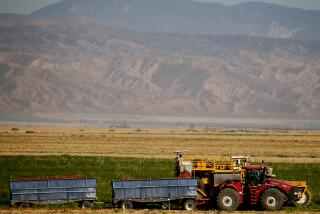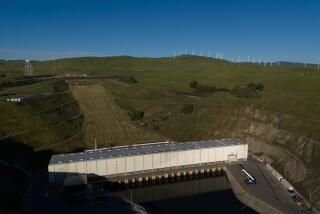Lake Cuyamaca Suffers as a Sagging Economy Slows Summer Fishing
- Share via
Hugh Marx doesn’t need to analyze San Diego County’s declining tourism numbers to see that something fishy is going on in the nation’s economy.
As the general manager of the Lake Cuyamaca Recreation and Park District in East County, Marx is a man who is used to viewing the economy in terms of bait sales, boat rentals and lake user fees, all of which he says are way down this year.
“Usually, when times are good, fishermen will come in, and they’ll buy night crawlers, Power Bait, Zeke’s floating cheese and salmon eggs, all at once. Now . . . they’re buying Power Bait or night crawlers one bait at a time,” Marx said.
“I can see that (the fishermen) are really watching their money a lot more closely,” he added. “We’re just not getting people spending the money like they used to.”
Declining business is not Marx’ only problem. Earlier this month, the California Department of Fish and Game announced that it will be cutting back the number of trout it plants each year in Lake Cuyamaca and at other Southern California fishing areas. Fewer trout could mean even less business.
Last year, the state planted 20,000 pounds of trout in the lake, which is just off California 79, about 40 miles east of San Diego. Budget cutbacks in the state hatchery program will mean that the number will be cut to 15,000 pounds in 1990. Next year, the state allotment will be cut even further, to 10,000 pounds, Marx said.
Curt Taucher, a regional spokesman for the DFG, said the reduction in Cuyamaca’s allotment was part of a $10-million, legislatively-imposed budget cutback imposed on the department that specifically called for the closing of the Mojave River Hatchery in San Bernardino County.
Taucher said it could have been worse for Lake Cuyamaca. A number of other Southern California fishing areas, including four in San Diego County, will receive no state-planted trout at all once the Mojave River hatchery closes in October.
Those fishing areas that were not eliminated from the trout planting program, including Lake Cuyamaca, will be supplied by the smaller Fillmore Hatchery in Ventura County, Taucher said.
Pending budget restoration legislation does not include funds to rescue the Mojave River Hatchery, he added.
Marx said the directors of the Lake Cuyamaca district will have no choice but to replace the state-supplied trout with fish from a private source if they want the lake to maintain its reputation as one of the best fishing spots in Southern California.
At $2 a pound, replacing the entire state trout allotment will cost $20,000.
“I don’t think my board will stock less fish,” Marx said. “(Fishermen) are of the opinion that they can’t catch fish unless the lake has been stocked within the last two weeks. . . . If you’d let them, they’d stand out there with a net behind the truck and catch the fish.”
Replacing the state fish with privately planted ones will not solve all of Marx’ problems, however.
Trout supplied by Cuyamaca’s private planter, the White Water Hatchery, weigh more than the trout provided by the state. So, even though Cuyamaca will have the same amount of fish in pounds, there will actually be fewer in the lake.
“When mom or dad brings the kids out to catch fish, they don’t care if it’s that big or that big,” Marx said, holding his hands out to indicate different sizes. “All they want to do is catch fish.”
As a result, the prospect of fewer fish for families to catch does not excite Marx, who said he is already concerned about anglers’ declining interest in Lake Cuyamaca.
“I’m seeing a decrease in our regular angler--anglers who last year we would see once a week,” Marx said. “Now we see them on the average of once a month.”
The Lake Cuyamaca district was established in 1962 by the state to provide a year-round recreational lake for San Diego County. The lake is leased for this purpose from the Helix Water District.
Even though the Cuyamaca district is a public agency, Marx said, he and the lake’s directors try to run it like a business. The lake’s operations are generally self-sufficient and are not subsidized with tax revenue.
“We’ve made a profit almost every year, and anything we make gets turned immediately back into the district,” Marx added.
This year, however, Marx said he is not sure the district will be profitable.
“I’m already losing money this year,” he said. The number of adult fishermen who come to his park is down by about one-third this summer--from 12,059 for the May through July period in 1989 to 8,042 for the same period this year.
“In terms of out normal business, we’re off by almost 50% this year,” he said.
Marx said he can already see the declining numbers of fisherman translating into lower revenues from boat rentals, launching and lake user fees, tackle shop sales and commissions on the sale of state fishing licenses.
During July, the district’s net revenues were down 63.5%, from $26,000 in 1989 to $9,500 in 1990.
In May, June and July, the district earned a combined $14,254, down nearly 72% from the $50,445 earned in the same three months last year.
Marx said he expects August’s figures to be in-line with those of the last few months. “Usually, I make enough in June, July and August to carry me through the rest of the year. That’s not the case this year.”
Declining attendance and revenue will make it difficult for the district to come up with the funds it will need to purchase the 10,000 pounds of state-planted trout it is losing.
“We will probably cut back in other areas, most likely staff,” Marx said. The district now employs 16 people. The district board of directors does not want to raise prices “with the economy down,” he added.
At the moment, a one-day lake user fee at Cuyamaca is $4 for an adult and $2 for a child. Children 8 and younger fish free when accompanied by an adult.
Full-day boat rentals are $8 or $17, depending on the type of boat. Half-day rates range from $6 to $13.
Marx also sells state fishing licenses, which cost $6.75 for the day or $21 for the year. The district receives a 50-cent commission for every license it sells.
The drought has not helped matters either, Marx said. “We are down 3 feet from where we would be ordinarily this time of year, but the lake still has a lot of fishable water.”
“If you think about it, because the lake is smaller and we (will still plant) the same amount of fish, it should be easier” to catch the fish, Marx said.
Marx also attributed some of the decline in his business to a weed problem caused by the lower water levels and uncomfortably high temperatures earlier in the summer.
“The fish love the weeds but the fishermen don’t,” he said. “If a fisherman casts out and brings in a big chunk of salad, it just ruins his day.”
Nevertheless, Marx said he became convinced that a general weakening of the economy was the real reason for the slowdown when his business did not pick back up after the weed problem was eliminated.
“My guess right now is that, until the economy turns around, business is going to be slow for everybody,” Marx said. “Some recreation stands up better under slow times than others. But it doesn’t seem like this lake is experiencing that.”
More to Read
Inside the business of entertainment
The Wide Shot brings you news, analysis and insights on everything from streaming wars to production — and what it all means for the future.
You may occasionally receive promotional content from the Los Angeles Times.










